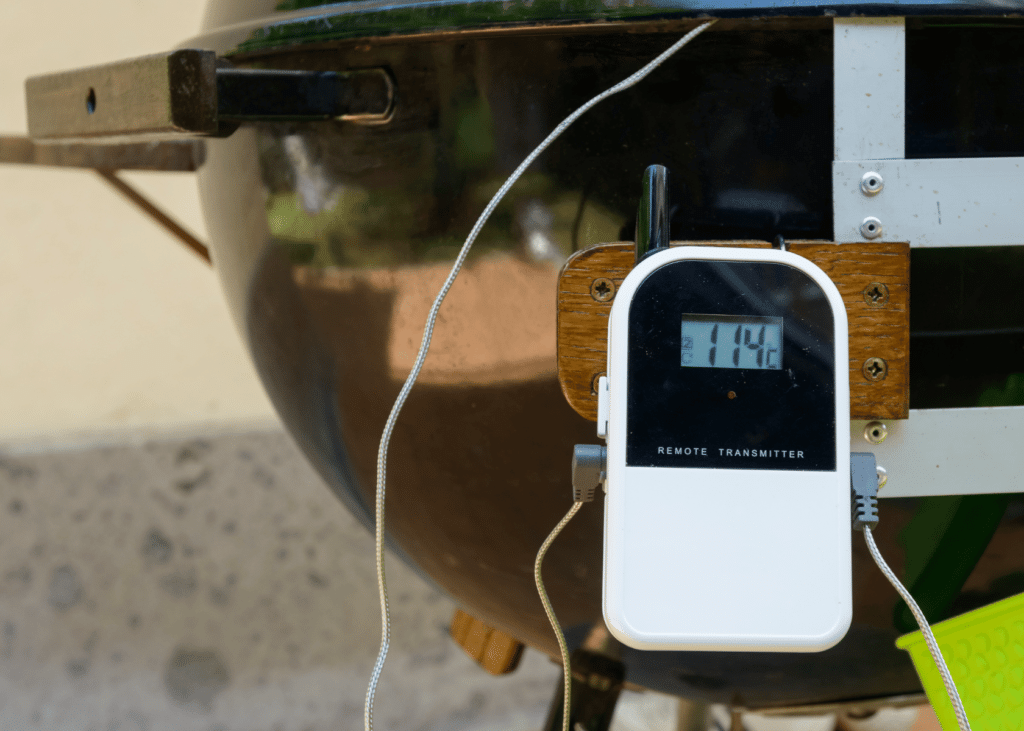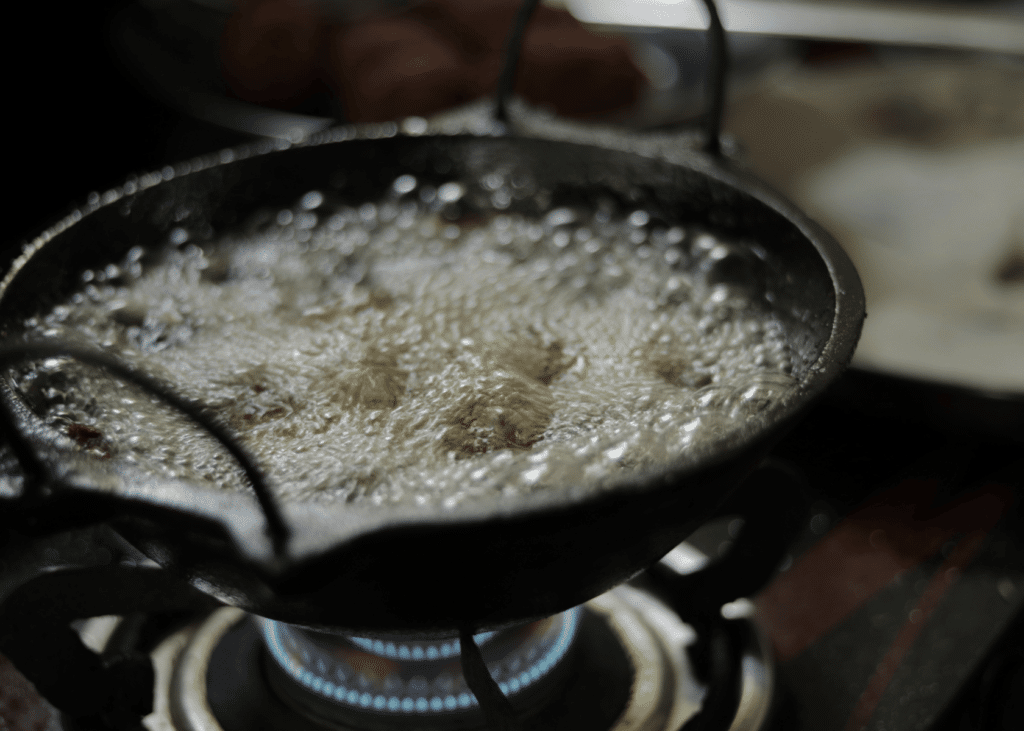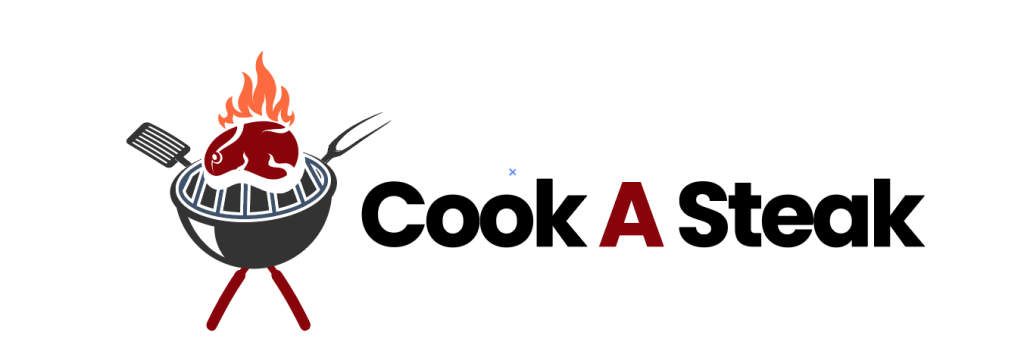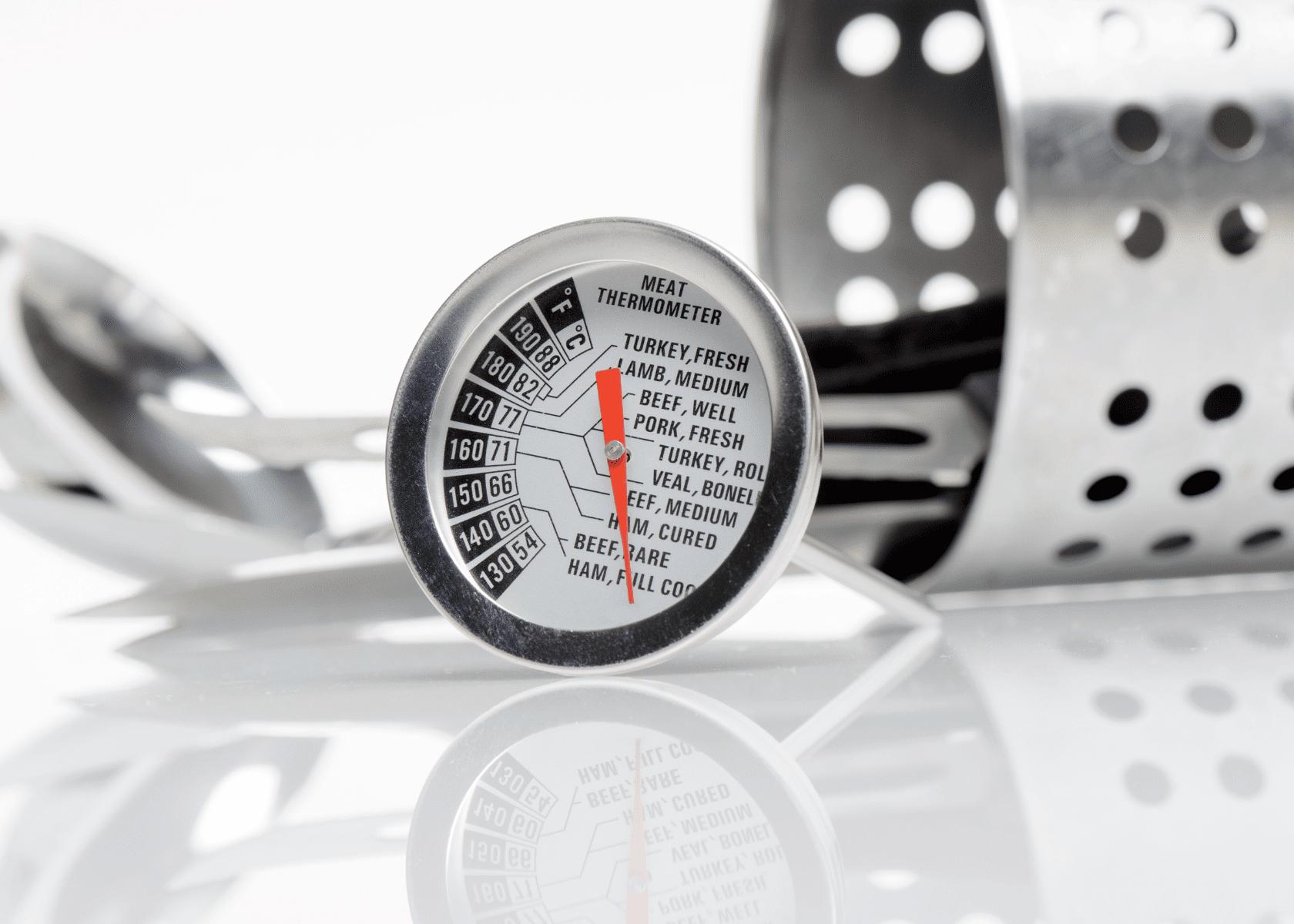Ever wondered if your meat thermometer could double as an oil temperature gauge? The truth is many cooking enthusiasts have successfully utilized their meat thermometers to measure the heat of their frying or cooking oil.
This blog post aims to unveil how you can safely and effectively use a standard meat thermometer for this unorthodox purpose, keeping in mind the varying heat resistance capacities it comes with.
Dive in to learn tips and tricks that will help improve your culinary skills while simultaneously answering the question – Can you use a meat thermometer for oil?.
Key Takeaways
- Using a meat thermometer for oil is possible as long as it can withstand high temperatures, typically up to 400 degrees Fahrenheit or more.
- Safety precautions should be taken when using a meat thermometer for oil, such as keeping a safe distance from the hot oil and slowly inserting the thermometer to prevent splattering.
- Accurate temperature control is crucial in cooking to achieve desired results and ensure food safety. A meat thermometer can help monitor and adjust temperatures with precision.
- There are different types of thermometers suitable for measuring oil temperature, including digital instant-read style thermometers, oven-safe meat thermometers, and candy thermometers.
Using a Meat Thermometer for Oil – Is it Possible?
Using a meat thermometer for oil is indeed possible due to its ability to withstand high temperatures, making it suitable for monitoring the temperature of cooking oils.
The ability of a meat thermometer to withstand high temperatures
A meat thermometer’s resilience to intense heat is crucial when measuring oil temperatures for cooking. Designed to test the internal temperature of foods such as roasts and steaks, these thermometers are intended to withstand high oven or grill temperatures.
Therefore, it should be suitable for determining oil temperature in deep-frying settings if used correctly.
However, it is essential to know that not all meat thermometers are created equal. While most can handle typical cooking temperatures, you need a tool capable of withstanding up to 400 degrees Fahrenheit or more if using it in hot oil.
This necessity stems from the fact that many frying recipes require oil heated within this range—making a high-temperature tolerant meat thermometer an indispensable tool in your kitchen arsenal.
Safety comes first though: dipping your probe cautiously prevents hot spatter while obtaining an accurate reading. Even called a “meat” thermometer, its versatility extends towards correctly estimating the temperature of boiling cooking mediums such as oil or sugar syrup – just another testament the multipurpose nature of this handy gadget!
Safety precautions when using a meat thermometer for oil
- Keep a safe distance from the hot oil to avoid burns.
- Use an oven mitt or heat – resistant gloves when handling the meat thermometer in the oil.
- Slowly and carefully insert the meat thermometer into the oil to prevent splashing or spattering.
- Avoid touching the sides or bottom of the pan with the meat thermometer, as they may be hot.
- Do not leave the meat thermometer unattended in the hot oil.
- Always read and follow the manufacturer’s instructions for safe use of the meat thermometer.
- Make sure that the meat thermometer is clean and dry before using it in hot oil to avoid any contamination.
Recommended Oil Temperature for Cooking
Knowing the ideal temperature for different cooking methods is essential to achieve perfect results.
Understanding the ideal temperature for different cooking methods

To achieve perfect results in your cooking, it is crucial to understand the ideal temperature for different cooking methods. Here are some key temperature ranges to keep in mind:
- Searing: Searing meat at high temperatures helps create a flavorful crust. Heat your pan or grill to a sizzling 400-450 degrees Fahrenheit.
- Deep Frying: To achieve crispy and evenly cooked fried foods, maintain the oil temperature between 350-375 degrees Fahrenheit. This allows the food to cook quickly without becoming greasy.
- Roasting: For tender and juicy roasts, preheat your oven to around 325-350 degrees Fahrenheit. This low and slow method ensures even cooking throughout the meat.
- Baking: When baking delicate pastries or cakes, set your oven temperature between 325-375 degrees Fahrenheit depending on the recipe. This allows for gentle and gradual heat distribution.
- Candy Making: Making candies requires precise temperature control. Use a candy thermometer and monitor temperatures between 235-310 degrees Fahrenheit for various stages of candy making such as soft ball, hard crack, or caramelization.
- Sous Vide Cooking: In sous vide cooking, food is vacuum-sealed and cooked in a water bath at controlled temperatures for extended periods. Temperatures can range from as low as 130 degrees Fahrenheit for rare steaks up to 185 degrees Fahrenheit for tougher cuts that require longer cooking times.
Importance of accurate temperature control in cooking
Accurate temperature control is crucial in cooking as it ensures that food cooks evenly and safely. Whether you’re grilling, baking, or frying, knowing the precise temperature is essential for achieving the desired results.
For example, if you’re cooking a steak on the grill, an accurate temperature reading will help determine whether it’s rare, medium-rare, or well-done. Similarly, when deep frying foods like chicken or French fries, maintaining the correct oil temperature ensures that they turn out crispy and delicious.
Without proper temperature control, food may end up overcooked on the outside and undercooked on the inside. Using a meat thermometer for oil allows you to monitor and adjust temperatures with accuracy and precision – giving you more control over your cooking process.
In addition to determining doneness levels and achieving desired textures, accurate temperature control also plays a role in food safety. Bacteria can thrive within certain temperature ranges known as the “danger zone,” which is between 40 to 140 degrees Fahrenheit (4-60 degrees Celsius).
By ensuring that your food reaches proper internal temperatures during cooking – such as 165 degrees Fahrenheit (74 degrees Celsius) for poultry – harmful bacteria are effectively killed off.
Types of Thermometers Suitable for Measuring Oil Temperature
There are several types of thermometers that are suitable for measuring oil temperature, including digital instant-read style thermometers, oven-safe meat thermometers, and candy thermometers.
Digital instant-read style thermometers
Digital instant-read style thermometers are a popular choice for measuring oil temperature due to their accuracy and ease of use. These thermometers provide quick readings, allowing you to monitor the temperature of your cooking oil in real-time.
They feature a digital display that shows the precise temperature, eliminating any guesswork. With their fast response time, digital instant-read style thermometers help ensure that your oil reaches and maintains the desired temperature for optimal cooking results.
It is important to choose a thermometer that can withstand high temperatures, typically up to 400 degrees Fahrenheit or more, to ensure accurate readings when using it with hot oil.
Oven-safe meat thermometers
Oven-safe meat thermometers are a reliable option for measuring the temperature of oil when cooking. Designed to withstand high temperatures up to 400 degrees Fahrenheit or more, these thermometers offer an accurate reading without compromising safety.
They are specifically constructed to be heat-resistant, making them perfect for monitoring the temperature of oil in deep-frying or oven-baking applications. With their durable construction and easy-to-read displays, oven-safe meat thermometers provide convenience and peace of mind when it comes to ensuring your oil is heated to the ideal temperature for cooking delicious meals.
Candy thermometers
Candy thermometers are another type of thermometer suitable for measuring oil temperature. These thermometers are specifically designed to handle high temperatures and provide accurate readings needed for candy making.
They usually have a long probe that can be immersed deep into the oil without any risk of burning yourself. Candy thermometers often come with clips or hooks that attach them securely to the side of a pot, ensuring stability during cooking.
With their clear temperature markings and precision control, candy thermometers can be a reliable tool when using oil for deep frying or any other culinary endeavors requiring precise heat adjustments.
Tips for Using a Meat Thermometer for Oil

To ensure accurate and reliable temperature readings when using a meat thermometer for oil, always insert the probe into the thickest part of the oil without touching the sides or bottom of the pan.
Ensuring accuracy and reliability of temperature readings
To ensure accurate and reliable temperature readings when using a meat thermometer for oil, follow these tips:
- Calibrate the thermometer: Before each use, calibrate your meat thermometer to ensure accurate readings. You can do this by testing it in ice water and boiling water. The thermometer should read 32 degrees Fahrenheit (0 degrees Celsius) in ice water and 212 degrees Fahrenheit (100 degrees Celsius) in boiling water.
- Insert the probe correctly: When measuring the oil temperature, insert the probe into the thickest part of the oil without touching the sides or bottom of the pot or pan. This will give you the most accurate reading.
- Avoid contact with steam or oil splatters: Be careful not to let hot steam or oil splatters come into contact with the meat thermometer. Not only can this affect accuracy, but it can also cause damage to both the thermometer and yourself.
- Wait for accurate readings: Allow sufficient time for the meat thermometer to stabilize and provide an accurate reading. This may take a few seconds depending on the type of thermometer you are using.
- Check for consistency: To ensure reliability, check that multiple readings taken from different areas of the oil yield consistent results. This will help confirm that your meat thermometer is accurately measuring the temperature throughout.
- Clean and maintain regularly: Properly clean and maintain your meat thermometer after each use to prevent any residue buildup or contamination that could affect its accuracy. Follow manufacturer guidelines for cleaning and storage.
Proper cleaning and maintenance of the meat thermometer
Proper cleaning and maintenance of the meat thermometer is essential to ensure accurate temperature readings and extend its lifespan. Here are some important tips to follow:
- Wash the meat thermometer after each use with hot, soapy water. Use a soft cloth or sponge to clean the probe thoroughly.
- Rinse the thermometer under running water to remove any remaining soap residue.
- Sanitize the meat thermometer by wiping it with a solution of one part bleach to nine parts water, or use an alcohol wipe. Ensure that all surfaces, including the probe, are properly sanitized.
- Dry the thermometer completely before storing it. Moisture can lead to bacterial growth and damage the internal components.
- Store the meat thermometer in a clean, dry place, away from direct heat or sunlight. This will prevent any potential damage and ensure its accuracy.
- Regularly check for signs of wear or damage, such as cracked glass or loose connections. If you notice any issues, it may be time to replace your thermometer.
- Calibrate your meat thermometer periodically to ensure accurate readings. You can do this by testing it in ice water (32°F/0°C) and boiling water (212°F/100°C). Adjust accordingly if there is any deviation from these temperatures.
- Avoid exposing the meat thermometer to extreme temperatures outside of its operating range, as this can affect its accuracy.
- Never immerse the entire thermometer in water or submerge it in dishwater as this can damage internal electronics.
- Use a protective sleeve or case when transporting or storing your meat thermometer to prevent accidental damage.
- Clean and sanitize after each use
- Dry thoroughly before storage
- Check for signs of wear or damage regularly
- Calibrate periodically using ice water and boiling water tests
- Avoid exposure to extreme temperatures
- Use protective sleeve or case for storage and transport.
Frequently Asked Questions
1. Can I use a meat thermometer for testing the temperature of oil?
While it is technically possible to use a meat thermometer to test the temperature of oil, it is not recommended. Meat thermometers are designed for lower temperature ranges and may not accurately measure the high temperatures required for frying or deep-frying.
2. What type of thermometer should I use for measuring oil temperature?
For measuring oil temperature accurately and safely, it is recommended to use a candy or deep fry thermometer. These thermometers are specifically designed with higher heat resistance and precise temperature readings suitable for cooking oils.
3. Why shouldn’t I use a meat thermometer for oil?
Using a meat thermometer instead of an appropriate oil thermometer can result in inaccurate readings, which can affect your cooking results and potentially lead to undercooked or overcooked food. Additionally, exposing a meat thermometer to extremely high temperatures may damage or break the device.
4. Where can I find an oil-specific thermometer?
Oil-specific thermometers, such as candy or deep fry thermometers, can be found at kitchen supply stores, online retailers specializing in culinary tools, and some department stores that have kitchenware sections. It’s important to ensure you purchase one that has been specifically designed for measuring high temperatures associated with cooking oils.
Conclusion
In conclusion, using a meat thermometer for oil is indeed possible and can be quite useful in monitoring the temperature while cooking or deep frying. However, it’s important to ensure that the meat thermometer you use can handle high temperatures of 400 degrees Fahrenheit or more.
By following safety precautions and accurate temperature readings, you can make your cooking experience safer and more enjoyable. So don’t hesitate to repurpose your trusty meat thermometer for oil-related tasks in the kitchen!

